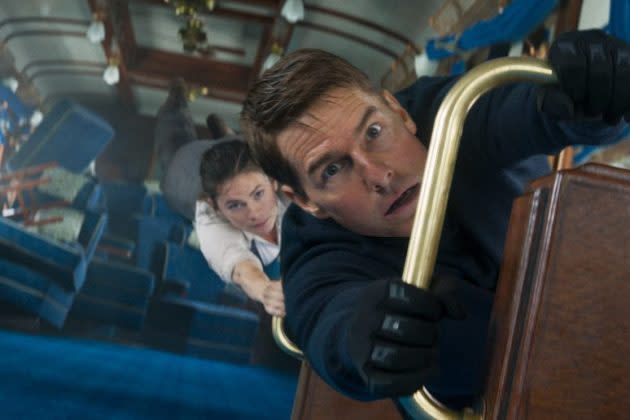Is the ‘Mission: Impossible’ Series Due for a Reckoning?

When did the “Mission: Impossible” films become action movies? I’m not sure when that happened, but I do know this much: For a series like the one in question, it’s live by the action, die by the action. For a few days there, people were chattering about all the great action in “Dead Reckoning Part One,” talking up the Fiat car chase or that train-dangling-from-a-cliff climax as if we’d never seen a sequence like that one before. But all I could think was, “Don’t we have the ‘Fast and Furious’ franchise for that?”
For 27 years, the “Mission: Impossible” films have been dotted with great action. That’s part of what these movies are. In a funny way, though, it can’t be the essence of what they are. Because then, no matter how spectacular Tom Cruise’s latest P.T. Barnum feat of star-in-the-air stunt work is (at this point how could he top himself short of doing a spacewalk?), the rest of the film inevitably recedes behind it. If “Dead Reckoning Part Two” weren’t already on the way (most of the movie was shot last year), I’d make the following recommendation to Cruise and his collaborator-auteur, director Christopher McQuarrie: If you really want to end this series on a high note, go back to the thing people loved about “Mission: Impossible” in the first place — the Russian-doll cleverness, the borderline insane trickiness, the way these movies are espionage thrillers turned inside out. If you made a great one of those, then instead of okay-to-disappointing box-office returns you might hold audiences in the palm of your hand as surely as they’re eating up “Oppenheimer.”
More from Variety
I grew up watching the original “Mission: Impossible” series on television with my father. I was 10, 11, 12 years old and could barely follow what was going on, but when those puzzle plots came together I still felt the rush. The series had almost no “action.” It was all deftly absurd, precision-cut, trap-door spy games. In 1996, when director Brian De Palma turned the show into a movie (at that point it wasn’t clear that he was spawning a franchise), he came up with a seductive hybrid: more action-driven than the show had been, but with enough narrative duplicity to bedazzle and pull the floor out from under the audience. The most memorable episode in the movie — Cruise hanging from that wire, performing the ultimate cat-burglar heist, a sequence so tense that a falling drop of sweat felt like a bomb — was at once pure action and pure intrigue.
The “M:I” movies have varied greatly, in tone and quality, to the point that there’s not a lot of consensus as to the highlights. Most of them are fun, and we all have our soft spots (I’m still awed by certain moments in John Woo’s “Mission: Impossible 2,” one of the least-loved entries in the series). But to me the greatest “M:I” film, the one extraordinary enough in its trickery to hypnotize and prank the audience, is Brad Bird’s “Mission: Impossible — Ghost Protocol.” I still think Cruise’s suction-cup spider crawl over the sleek surface of the Burj Khalifa is the most cinematic stunt of his career, and Bird orchestrated a grand illusion of perception in the rest of the movie.
I thought something like that might happen in “Dead Reckoning Part One” as I watched the early airport pickpocket chase sequence, which is the film’s most breathlessly effective episode. It’s all gambits and reversals, and it introduces a very “Ghost Protocol” idea: that the Entity — otherwise known as the Internet gone AI rogue — could virtually camouflage a character like Esai Morales’ Gabriel. That concept feels like it could be the next evolution of the “M:I” masks. But the film introduces the idea only to do next to nothing with it. On the technological-deception scale, the airport sequence is “Dead Reckoning’s” high point, which is another way of saying that the movie culminates too early.
Action will always be part of cinema, and the “Mission: Impossible” movies have every right to aim for stupendous action sequences. If it sounds like I’m begrudging the evolution of Cruise’s stuntman brand, on the contrary: I’d never deny the excitement, or fanatical bravado, of what he does. A few years ago, I wrote admiringly of how those stunts have become the measure of his stardom, and I stand by that assessment. Yet the ballpark-similar, barely-good-enough-to-get-by domestic box office grosses of “Mission: Impossible — Dead Reckoning Part One” ($150 million), “Indiana Jones and the Dial of Destiny” ($170 million) and “Fast X” ($145 million) should be telling us something: that action, as a selling point, may have peaked, entering a period of overexposed exhaustion. Of all those franchises, the “M:I” films are the last ones that should be coasting on the coolness of a Fiat 500 zooming around Rome. Cruise and McQuarrie’s mission, should they choose to accept it, is to make this series fascinating again by remembering that the ultimate movie stunt is still the one that wows your brain.
Best of Variety
Sign up for Variety’s Newsletter. For the latest news, follow us on Facebook, Twitter, and Instagram.

 Yahoo News
Yahoo News 